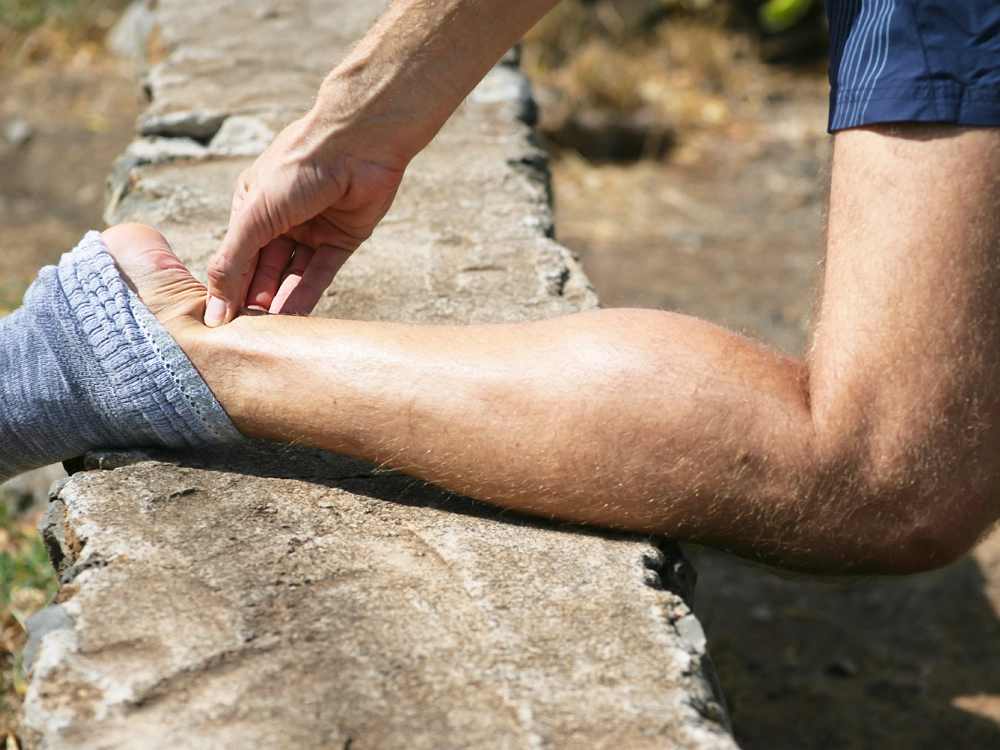Achilles tendinopathy is a condition that affects the Achilles tendon, which is the largest and strongest tendon in the body. It connects the calf muscles to the heel bone and is responsible for helping us walk, run, and jump. If you are experiencing pain or stiffness in your Achilles tendon, you may have Achilles tendinopathy. In this article, we will discuss physiotherapy treatment options for this condition.
Contents
What Is Achilles Tendinopathy?
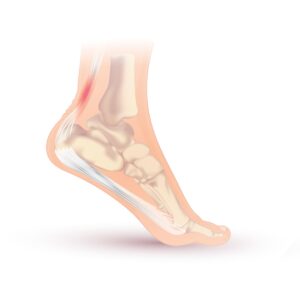 Achilles tendinopathy is a common condition affecting the Achilles tendon, which joins your calf muscles to the heel of your foot. It causes pain and swelling along with stiffness in the affected area and can develop gradually over time. Achilles tendinopathy mostly affects people who are into sports that involve running or jumping such as tennis, basketball, and badminton. It also affects people who stress a lot on the Achilles tendon, such as stepping up from one level to another. The condition also tends to affect people who are relatively inactive for long periods of time.
Achilles tendinopathy is a common condition affecting the Achilles tendon, which joins your calf muscles to the heel of your foot. It causes pain and swelling along with stiffness in the affected area and can develop gradually over time. Achilles tendinopathy mostly affects people who are into sports that involve running or jumping such as tennis, basketball, and badminton. It also affects people who stress a lot on the Achilles tendon, such as stepping up from one level to another. The condition also tends to affect people who are relatively inactive for long periods of time.
Dull or sharp pain at the back of your heel, tenderness when the tendon is pressed and swelling are symptoms of Achilles tendinopathy. In more severe cases where there is inflammation in the Achilles tendon, you may also experience heat and redness along with a crackling or creaking sound which comes from the Achilles tendon when it’s moved.
If you think you may have Achilles tendinopathy, you should see a doctor or physiotherapist to confirm the diagnosis.
How Do You Treat Achilles Tendinopathy?
Achilles tendinopathy can usually be treated at home. With rest and exercises to stretch and strengthen your calf muscles, this pain can subside soon. But if the tendon becomes more inflamed, it may require specialised treatment in hospitals such as an ultrasound scan or steroid injections.
Physical Therapy
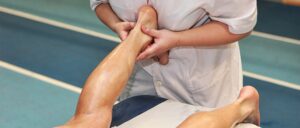 Achilles tendinopathy is often diagnosed by physical therapy. They will examine your Achilles tendon and may ask you to do certain movements, such as standing on your toes or hopping on one leg, in order to see how much movement there is in the area of the damaged tendon. By using both manual therapy and exercise therapy physical therapy can cure Achilles Tendinopathy.
Achilles tendinopathy is often diagnosed by physical therapy. They will examine your Achilles tendon and may ask you to do certain movements, such as standing on your toes or hopping on one leg, in order to see how much movement there is in the area of the damaged tendon. By using both manual therapy and exercise therapy physical therapy can cure Achilles Tendinopathy.
- First, they might use techniques such as massage or cupping to help reduce the inflammation and scar tissue in the area. They may also apply ice or heat packs depending on which is more suitable for your condition.
- Secondly, you will be required to do exercises and stretches to strengthen calf muscles so that there is less pressure on your Achilles tendon. Stretching exercises can be done every day, either at home or in-patient. They usually involve moving your foot and pointing it as far downward as possible. Calf muscle strengthening exercises will help build up the strength of this area to support your Achilles tendon better so that you do not injure it again. Exercises involving straight knees will put extra strain on this tendon and should be avoided.
If you have more severe symptoms, your physiotherapist may recommend other treatments such as ultrasound therapy or steroid injections in order to reduce swelling of the tendon so that it can heal better.
Corticosteroids Injections
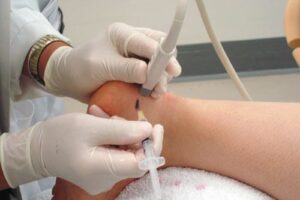
Steroid injections are often used to treat severe Achilles tendinioathy. Although corticosteroids are a class of medications related to the steroid cortisone, they work by reducing inflammation in a diseased tendon. This technique is effective in alleviating pain associated with the condition. There have been many studies conducted on the use of corticosteroid injections for Achilles tendinosis, but results are conflicting because there is no inflammatory process present. It does relieve for a short span of time, but not for the long term.
If you are considering a corticosteroid injection for your Achilles tendinopathy, it is important to discuss the pros and cons with your doctor first. Infection, tendon rupture, and worsening symptoms are some risks associated with this kind of treatment.
Shock Wave Therapy
Shock wave therapy is another mode of treatment for Achilles tendinopathy. Non-surgical procedure uses high-energy sound waves to stimulate the healing process in your injured tendons. Shock waves are passed through water into soft body tissues. These stress waves cause microtrauma (damage) at a cellular level and trigger the release of growth factors which promote tissue repair and regeneration.
Laser Therapy
Laser treatment is another cure for Achilles tendinopathy. This treatment aims to reduce pain, swelling and inflammation as well as encourage the natural repair of the tissue.
Laser therapy is a popular treatment option for Achilles tendinopathy because it can provide fast results with minimal side effects. Unlike conventional treatments such as medication or surgery, laser therapy does not involve any invasive procedures and is a safe and non-invasive therapy.
Operative Treatment
This treatment for Achilles tendinopathy involves the surgeon cutting into the tendon and removing any damaged portions of tissue. The remaining tendon is then sutured with either stitches or a special tape to improve its ability to function.
While this treatment option can help patients achieve pain relief, it comes at the cost of significant recovery time and a possible risk of complications such as infection or nerve damage.
Other treatments for Achilles tendinopathy include stretching exercises, orthotic devices, plasma treatment, etc. Each of these options has its own benefits as well as potential side effects, so it is important to discuss them with your doctor in order to determine which treatment option is right for you.
Is Physical Therapy The Best Treatment For Achilles Tendinopathy?
It is physical therapy that mostly treats Achilles tendinopathy because it’s safe and efficient.
Achilles Tendinopathy occurs when the Achilles tendon, which connects the heel to the calf muscles becomes inflamed or irritated. This inflammation can develop due to wearing high-heeled shoes, running long distances on hard surfaces, and other factors.
Physical therapists work with patients to design a customized treatment plan that focuses on improving flexibility, strength, and pain-relieving techniques specific to each patient’s needs.
Overall, physical therapy is the most effective treatment option for Achilles Tendinopathy and can help patients achieve pain relief and improved function. If you are struggling with this condition, talk to your doctor or physical therapist today about how they can help you manage your symptoms and get back on the path to recovery.
Will Achilles Tendinopathy Ever Go Away?
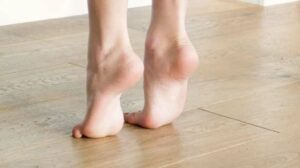
Treating Achilles tendinopathy is a long process and symptoms can take several months to completely disappear. Therefore, it’s important to follow the advice of your physiotherapist in order to minimise the risk of further damage. You should also avoid doing any activities which could make your tendon worse.
While there is no guaranteed cure for Achilles tendinopathy, many patients find that their symptoms begin to improve after undergoing a course of physical therapy. Physical therapy works by targeting the root cause of Achilles tendinopathy. You can treat it by doing:
- Stretches and exercises
- Massages
- Cold compression
- Ultrasound
While Achilles tendinopathy can be a frustrating injury, it is important to remember that you are not alone. Many people have experienced the symptoms of this condition and successfully treated it through physical therapy, so if you are struggling with Achilles tendinopathy, don’t hesitate to reach out for help and start your journey.
When Should I Worry About Achilles Tendinopathy?
Physiotherapy is a great option to cure Achilles tendinopathy. However, if you have been experiencing acute pain for longer than two weeks and your symptoms do not seem to be improving, it may be time to seek the help of a professional. The following are some key signs that your Achilles injury needs professional attention:
- Your pain is severe and debilitating.
- You have experienced swelling around your Achilles tendon.
- The area feels tight and stiff, especially after activity.
- Your Achilles tendon makes a popping or cracking sound when you move it.
Achilles tendinopathy will cause discomfort when it’s not treated in time. Some of those conditions include:
- Pain can become severe and limit mobility in the affected area. This could lead to interference with everyday activities such as walking, running, jumping, and climbing.
- Scar tissue may form in the Achilles tendon if it is not treated, which can lead to long-term pain.
- In severe cases, an Achilles rupture could occur if left untreated for too long. This would require surgery to repair the damage, and would require a long period of rehabilitation.
Therefore you should be very alert when listening to your body’s needs and seek professional help as soon as possible.
Conclusion
In conclusion, you should always see a professional whenever you experience discomfort. Pain at the heels could be a sign of something more serious. If not taken seriously or treated in time, this can lead to serious complications.
Physical Therapy help patients recover from pain. If you’re experiencing Back pain, Shoulder pain, Knee pain, Neck pain, Elbow pain, Hip pain, or Arthritis pain, a physical therapist at MantraCare can help: Book a physiotherapy session.
